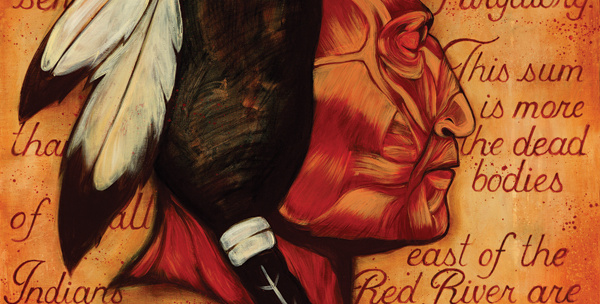Editor’s Note: This commentary was originally published in Education Week on Feb. 18, 2015. The author is a senior at Neshaminy High School, in Langhorne, Pa., and the editor-in-chief of the school’s newspaper, The Playwickian.

When I raised my hand to vote in a classroom at Neshaminy High School nearly 18 months ago, I was unaware of the battle I was about to ignite as editor-in-chief of The Playwickian, my school’s newspaper. In the fall of 2013, one of my fellow editors began a conversation about our school mascot, which is also the name of every sports team at our school and our school’s nickname. This would soon become a national controversy over our use of a racist mascot and a legal battle over the amount of control students have over their publications in public schools.
This mascot is the “Redskin.” It has been consistently criticized by a Native American parent within our school district for its derogatory and hateful connotation. The paper’s staff and I came to a consensus that we should listen to what this parent had to say and start a conversation about the future use of the mascot, given how offensive it is to Native Americans. We debated, did our research, and ultimately came to a vote—14-7—in favor of removing the mascot—and the football team’s name—entirely from our newspaper, essentially forming a new policy. Both the majority and the dissenting sides wrote editorials, and we went to press Oct. 23, 2013.
As the editor-in-chief since 2013, I continue to face reproach for this decision, including the possibility of criminal charges, as well as a lot of social-media bashing by my peers and the parents in my school district.
My high school is known for its strong athletic program and as a football powerhouse, making it to the playoffs almost every year. With an environment focused on school sports and a population of 2,600 students, there is a foundation built on school spirit. From “gym night,” our school’s version of spirit night, to football games, an entire community is enriched by these traditions. So when we published our editorials and our stance on the mascot name, pushback came not only from the community, but the student body as well. We took the initial heat from the community and our peers and thought we would be on our way, until we faced opposition from the last place we expected—our administration.

A few days after we published the editorials and the student body’s reaction had slowly begun to die down (painful though it was), my principal, Robert McGee, sent a directive to our newspaper adviser, Tara Huber. In this directive, he said that our “new” policy would be put on “hold,” and that we were not permitted to edit or reject any letters to the editor, advertisements, or articles that featured the mascot. So this policy that we had just formed carefully and precisely was now suddenly reversed.
Nothing about this directive seemed right. The administration was telling us we had to use a word that we had researched and agreed is derogatory. I found myself calling every student press association I could find, trying to gather any case law, state code, or policy that could prove to my principal that we had the right to reject the use of the mascot in the student-run school newspaper. I contacted the Student Press Law Center, the Pennsylvania School Press Association, and the Journalism Education Association. They all provided me with different statutes that proved our right to form policy. West Virginia State Board of Education v. Barnette and Tinker v. Des Moines Independent Community School District are just two of the U.S. Supreme Court cases that we found to back us, but the biggest protector of our rights can be found in our state Pennsylvania code that refers to students and student services. The state code neutralizes the impact of the U.S. Supreme Court’s decision in Hazelwood School District v. Kuhlmeier, which denies student editors the right to make their own judgments.
In Chapter 12, Section 9, “Freedom of expression,” the state code reads: “Students have a right and are as free as editors of other newspapers to report the news and editorialize.” And this is exactly what we were doing: taking a stance against our mascot and editorializing, just as the law permits. We cannot be compelled to publish a word—or image—that we, ourselves, have deemed offensive. In that respect, we reserve the right to remove the mascot from our publication entirely.
When we printed the next edition of the newspaper without the image or name of the mascot, it did not go over well. Students ripped the paper up and threw it on the ground in the school hallways. They even threatened to take it home and set it on fire. I walked into a homeroom, and as I began to hand out the newspapers, one student crossed her arms and said, “I’m not touching that.” When you hear this from a peer about something you struggled for more than 10 hours to complete, it is unbelievably discouraging. My fellow students couldn’t separate the mascot issue from the rights of the student press.
Many saw this situation merely as a group of kids wishing to challenge tradition and authority, rather than a group of kids that wished to have a reasonable degree of autonomy over their own work. We were labeled enemy No. 1: “the kids trying to change the mascot.” When we began this conversation about our mascot, we knew we were in the minority. We never anticipated the fallout.
As discouraging as it was not having the student body and community on our side, I came to realize that the stance we were taking was worth much more than the feeling of acceptance and approval that most teenagers strive for. Furthermore, the law and state policy were on our side.
Many news outlets and professional journalists across the country—76, according to an October 2013 study from the Pew Research Center, including The Washington Post—have established policies in which they have limited the use of the name of Washington’s NFL football team. And the law grants students this same control over their publications.
By removing the mascot from our publication, we not only did what was morally right, we did what was legally right.
Gillian McGoldrick is a senior at Neshaminy High School, in Langhorne, Pa., and the editor-in-chief of the school’s newspaper, The Playwickian.



